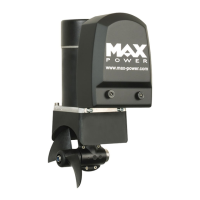Last update: February 2018
Ensure that all electrical connections are correctly tightened.
Under no circumstances any flammable products not to be stored next to
electrical components of the thruster.
It is essential to install a manual battery isolator and if possible an electric
battery isolator at the base of the thruster motor power line.
When using a manual battery isolator it must be visible, clearly marked & easily
accessible.
Thruster motor power supply:
These values are given as an indication, assuming that the batteries are charged at
100% and in charge and charging voltage should be 13.8V.
The performance data of the CT25 is measured with an approx. consumption of
250 Amps and approx. 11V at the motor’s connections.
Please refer to the characteristics given by the manufacturer of the batteries that will be
used (see section 9 “Batteries”).
Power wiring:
Measure the shortest and most direct route possible between the battery(ies) and the
electric motor; remembering to allow for both “positive and negative” wires.
Recommended cable sections:
For all connections, use appropriate terminals for the cable sections chosen.
It is possible to reduce the cable section to facilitate easy connection but only over a
short distance. In this case, appropriated crimp fittings should be used at the
connections.
Please consult the "Electrical installation" diagram p. 11 for more information
8. MAIN POWER FUSE
Fuse sizes for overcurrent protection are to be determined on the basis of the cable
sections in the circuit and NOT the amperage drawn by the appliance (thruster motor) in
the circuit.
9. BATTERIES
Thrusters are high amperage consumers with instantaneous demands, thus, we
recommend you use maintenance-free “starting” type batteries, with high CCA
outputs.
For
example: Exide Maxxima 900, 12V, capacity 55Ah / starting current 800CCA.

